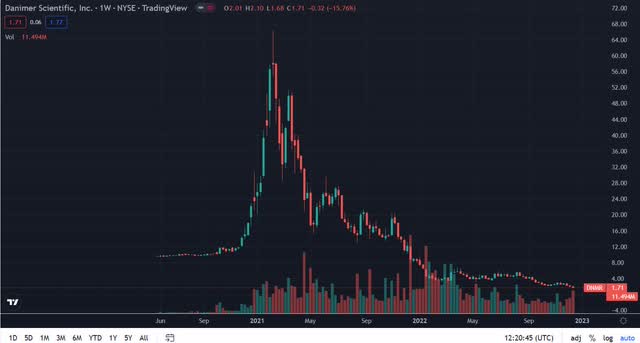Daisy-Daisy/iStock via Getty Images
Danimer Scientific, Inc. (NYSE:DNMR), a company that competes in the market that supplies bioplastic replacements for traditional petroleum-based plastics, is coming off a very weak quarter, and based upon guidance, it looks like things are going to get worse before they get better.
Part of the problem is the current macro-economic environment where its customers are tightening up on spend as decision-making is pushed up to higher levels of management. That has resulted in delays and potential sales being pushed out further into 2023 and beyond.
The company is working on increasing production capacity in response to growing demand in some segments of the market, but is struggling to maintain its current growth potential, even as it is burning cash at a high rate.
In order to finance the potential opportunities before it, the company has submitted “a Part II Application for a loan guarantee under the U.S. Department of Energy (DOE) Title XVII Loan Guarantee Program,” which if approved, would primarily be used to expand its capacity.
Even though management claims it could move forward with or without the loan approval, it would suggest to me it would have to access the equity market in order to do so, and that would further dilute shareholders if that’s the only way it can proceed without adding to its already significant debt load, which of course would get more expensive as interest rates continue to rise.
In this article we’ll look at some of the numbers from its last earnings period, concerns about its cash burn rate, and what the conditions of the market imply on its near and long-term future growth.
Some of the numbers
Revenue in the third quarter was $10.4 million, dropping $2.9 million, or 22 percent from the $13.4 million in revenue generated in the third quarter of 2021. The decline in revenue was attributed to PLA resin sales falling by $4.4 million compared to last year in the same quarter. Part of the drop in PLA resin sales came from the impact of “customer operations in Ukraine and Russia.”
During the reporting period PHA-based resin sales were up $1.1 million, or 26 percent year-over-year, and they now stand at $5.3 million, accounting for approximately 51 percent of total revenue.
Gross profit in the third quarter was negative $(4.1) million compared to $(0.2) million in the same quarter of 2021. Adjusted gross profit was $(0.8) million compared to $2.6 million in the third quarter of 2021. The decline in adjusted gross profit came from the weak PLA resin sales and higher fixed costs related to increased PHA capacity compared to the third quarter of 2021.
Adjusted EBITDA in the third quarter of 2022 was $(12.9) million compared to adjusted EBITDA $(7.4) million in the third quarter of 2021. Lower PLA resin sales and higher fixed costs associated with increased PHA capacity, increased costs related to Danimer Catalytic Technologies, an increase in R&D expenses, and adding to its employee count were behind the drop in adjusted EBITDA.
Cash and cash equivalents at the end of the third quarter were $99.1 million, with long-term debt of $286 million. By the end of calendar 2022 the company guides for cash and cash equivalents to fall to a range of $60 million to $65 million.
Adjusted EBITDA for the full-year 2022 is expected to be at negative $(45) million to negative $(40) million.
CapEx for full-year 2022 is projected to be in a range of $165 million to $170 million.
Macroeconomic and supply chain issues
In the current macro-economic environment, including supply chain issues, demand for DNMR’s products is hindered by timing factors in relationship to shipping of products.
While interest in the solutions offered by DNMR appears to be growing, the weak economy, high inflation, rising interest rates, and ongoing supply chain issues are causing existing and potential new customers of the company to put off buying and/or decisions on when and if to order products.
That said, some product launches are starting in 2023 with most of those expected to launch in the first half. I want to be clear here, those launches only reflect a portion of the launches and shouldn’t be considered a major catalyst that will have a significant impact on the growth trajectory of the company in the near term.
Concerning the near-term launches, the lack of capacity at its Kentucky facility won’t be able to produce the required amount of volume associated with PHA. The company appears to be saying it won’t be able to take full advantage of demand until it’s able to boost production capacity.
When asked about that, management said that it expects significant improvement at its Kentucky facility in 2023, but still expects volume to be on the low end in comparison to when it’s at full run rate. Expectations are in 2023 it’ll start slower but gain momentum in 2024.
To just fill the orders from those launches the company will need about 100 million pounds of PHA needed to fill the orders on an annual basis by 2026.
The point here is even with the product launches by its customers, the impact on the performance of DNMR is going to be gradual and incremental over the next year or so, and from approximately 2024 and on it should accelerate.
Further out, the company is working on increasing capacity by adding another facility in Georgia.
Major challenges
A problem DNMR must solve is its lack of ability to meet market demand. While it’s true that customers and potential customers have been more stringent on spend and will continue to be over the next year or so based upon expected weak economic conditions, that’s not the whole story, as even if they were ready to boost spend, DNMR wouldn’t be able to supply the demand, as mentioned above.
Not only that, but they are struggling to supply the market in a profitable manner, and there really isn’t any visibility concerning how long that’ll take. With dwindling cash and rising costs, the company must come up with a solution that extends its ability to operate as it waits for market conditions to improve while building out capacity at its Kentucky facility.
In other words, this is a catch-22 situation. The demand is there, but they don’t have the capacity to meet demand, and the revenue being generated, and the accompanying losses aren’t enough to invest back in the company in order to stimulate growth.
As mentioned earlier, the company may land a loan from the government that would presumably be an answer to some of these problems, but even if they get the loan it’s going to take some time to ramp up production capacity as its customers wait for supply.
Conclusion
The challenge for DNMR is in its lack of capacity in a market that is increasing in demand for products not produced from petroleum. The problem is, at this time it’s not able to produce at a level that is close to generating a profit, so with growing demand before it, it now has to resort to playing defense at a time when it could be getting more aggressive in its growth.
That’s not a negative in the short term as the company stands today, as it must conserve capital while its spending on growth initiatives, which should predominately be in relationship to boosting capacity at its Kentucky facility.
So while there is a lot of potential in the sector, DMNR is limited by its capacity to meet demand even as it continues to burn a lot of cash. This is going to take time to work through if it is able to maintain a relatively healthy balance sheet.
The bottom line to me is DMNR is competing in a growing sector that has a lot of potential for growth in the years ahead, but is constrained by production capacity, slowing sales, and shrinking margin, at a time when demand is increasing.
For that reason, I see the company as a long-term project that isn’t going to generate much in the way of meaningful results for at least a couple of years, and probably longer.
It needs to get more out of its Kentucky facility and add capacity in Georgia. That will take capital the company can’t afford to fully deploy at this time, or even has available to it.
Again, getting approved for the government loan would be strong catalyst, but even with enough cash-on-hand it’ll take time to increase its production capacity to meet even existing demand, let alone long-term demand.
Even after its share price plunging from approximately $66.00 per share in February 2021 to $1.71 as I write, it still may not be a good entry point depending on how things proceed in the first half of 2023.
The stock may be worth taking a small position in with some money set aside for speculative plays, but there are a lot of headwinds over the next couple of years that make it highly risky to put much capital into it.
For now, this is more of a trading stock based upon the news cycle, rather than a company that has laid the foundation for long-term, sustainable growth.



Be the first to comment